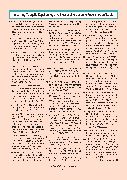Imparting Mosquito Repellent Agents & Assessing Mosquito Repellency on Textile Faulde, M., & Uedelhoven, W. (2006). A new clothing impregnation meth- od for personal protection against ticks and biting insects. Internation- al Journal of Medical Microbiology, 296, 225–229. Fei, B., & Xin, J. H. (2007). N, N-dieth- yl-m-toluamide–containing micro- capsules for bio-cloth finishing. The American Journal of Tropical Medi- cine and Hygiene, 77(1), 52–57. Fradin, M. S., & Day, J. F. (2002). Com- parative eficacy of insect repellents against mosquito bites. New En- gland Journal of Medicine, 347(1), 13–18. Frances, S. (1987). Effectiveness of deet and permethrin, alone, and in a soap formulation as skin and clothing protectants against mos- quitoes in Australia. Journal of the American Mosquito Control Asso- ciation, 3(4), 648–650. Geethadevi, R., & Maheshwari, V. (2015). Long-lasting UV protection and mosquito repellent finish on bamboo/tencel blended fabric with microencapsulated essential oil. Indian Journal of Fibre & Textile Research (IJFTR), 40(2), 175–179. Hall, A. J. (1966). Textile finishing Fi- nissage des textiles: American Elsevier. New York: NYUSA. Kongkaew, C., Sakunrag, I., Chaiy- akunapruk, N., & Tawatsin, A. (2011). Effectiveness of citronella preparations in preventing mosqui- to bites: systematic review of con- trolled laboratory experimental stud- ies. Tropical Medicine and Interna- tional Health, 16(7), 802–810. Koren, G., Matsui, D., & Bailey, B. (2003). DEET-based insect repel- lents: safety implications for chil- dren and pregnant and lactating women. Canadian Medical Associ- ation Journal, 169(3), 209–212. Lalit Jajpura, M. S., Abhilasa Rangi, Kalpana Chhichhilia. (2015). A Re- view On Mosquito Repellent Finish For Textile Using Herbal Extracts.International Journal of Engineering Sciences and Management Re- search, 2(8). Lupi, E., Hatz, C., & Schlagenhauf, P. (2013). The effcacy of repellents against Aedes, Anopheles, Culex and Ixodes spp.—a literature re- view. Travel Medicine and Infectious Disease, 11(6), 374–411. doi:10.1016/j.tmaid.2013.10.005. Maheshwari, V., & Ramya, K. (2014). Development of eco friendly mos- quito repellent fabric finished with Andrographis Paniculata plant ex- tracts. International Journal of Phar- maceutical Sciences, 6(5), 115– 117. Masetti, A., & Maini, S. (2006). Arm in cage tests to compare skin repel- lents against bites of Aedes albop- ictus. Bulletin of Insectology, 59(2), 157. McCamy, T., & Clark, W. H. (1996). In- secticidal carpet and pretreatment process for producing insecticidal carpet: google patents. Mweresa, C. K., Mukabana, W. R., Omusula, P., Otieno, B., Gheysens, T., Takken, W., & van Loon, J. J. (2014). Evaluation of textile sub- strates for dispensing synthetic at- tractants for malaria mosquitoes. Parasites and Vectors, 7, 376. doi:10.1186/1756-3305-7-376. N’Guessan, R., Knols, B. G., Pennet- ier, C., & Rowland, M. (2008). DEET microencapsulation: a slow-release formulation enhancing the residual eficacy of bed nets against malar- ia vectors. Transactions of the Roy- al Society of Tropical Medicine and Hygiene, 102(3), 259–262. Patel, E., Gupta, A., & Oswal, R. (2012). A review on: mosquito re- pellent methods. Int J Pharm Chem Biol Sci, 2(3), 310–317. Paya, J. G., Aracil, M. A. B., Aboy, P. M. R., & Perez, P. M. (2010). Insect Repellent Textile: google patents. Pennetier, C., Chabi, J., Martin, T., Chandre, F., Rogier, C., Hougard, NCM-OCTOBER 2021 44J.-M., & Pages, F. (2010). New pro- tective battle-dress impregnated against mosquito vector bites. Par- asites and Vectors, 3, 81. doi:10.1186/1756-3305-3-81. Phasomkusolsil, S., & Soonwera, M. (2011). Comparative mosquito re- pellency of essential oils against Aedes aegypti (Linn.), Anopheles dirus (Peyton and Harrison) and Culex quinquefasciatus (Say). Asian Pacific Journal of Tropical Biomedicine, 1(1), S113–S118. Rajkumar, S. & Jebanesan, A. (2007). Repellent activity of selected plant essential oils against the malarial fever mosquito Anopheles stephen- si. Tropical Biomedicine, 24(2), 71– 75. Roberts, D. R., Chareonviriyaphap, T., Harlan, H. H., & Hshieh, P. (1997). Methods of testing and analyzing excito-repellency responses of malaria vectors to insecticides. Journal of the American Mosquito Control Association, 13(1), 13–17. Rozendaal, J. A. (1997). Vector con- trol: methods for use by individuals and communities. In W. H. Organi- zation (Ed.), (pp. 59–87). Geneva: WHO. Retrieved from www.who.int/ water_sanitation_ health/resourc- es/en/vector059 to87.pdf. Schoepke, A., Steffen, R., & Gratz, N. (1998). Effectiveness of person- al protection measures against mosquito bites for malaria prophy- laxis in travelers. Journal of Travel Medicine, 5(4), 188–192. doi:10.1111/ j.1708-8305. 1998.tb00505.x. Shannon, K. (1988). Protective garment for protection against mosquitoes and other insects: google patents. Sholdt, L., Schreck, C. E., Mwangel- wa, M., Nondo, J., & Sianchji, V. J. (1989). Evaluations of permethrin- impregnated cloth- ing and three topical repellent formulations of deet against tsetse flies in Zambia. Medical and Veterinary Entomol- ogy, 3(2), 153–158. Contd. on page 54
